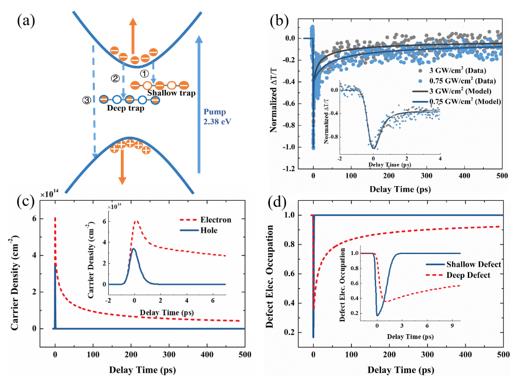Two dimensional (2D) materials, pioneered by graphene, have the huge potential to be the building blocks of future nanoelectronic and nanophotonic devices due to their ultrathin size, thickness-dependent bandgap, and ultrafast optical response. Recently, rhenium disulfide (ReS2), a rising member of transition metal dichalcogenides family, has triggered many novel studies in optoelectronic field on account of its peculiar bandgap evolution and has already shown unique properties in the application of field-effect transistors, digital devices, photodetectors, phototransistors and nonlinear optical modulators. However, the key parameter, which represents the performance of light-emitting devices in semiconductor, photoluminescence (PL) quantum yield, is in a low range of only ~0.0001 as reported previously. Detailed interpretation of the transient absorption spectra in near infrared range closely correlated to nonradiative recombination pathways is still very scarce and needs to be further explored.
Recently, a study led by Prof. WANG Jun from Shanghai Institute of Optics and Fine Mechanics, Chinese Academy of Sciences, investigated the ultrafast dynamics of trilayer ReS2 and revealed the defect-assisted Auger scattering combined with band to band Auger recombination as playing the dominant recovery mechanism in the charge carriers. This study has been published on Optical Material Express.
In their experiment, the carrier dynamics of trilayer ReS2 were investigated by pump-probe spectroscopy with broadband ultrafast laser pulses. The relaxation of excited carriers contained a fast and a slow decay component, which were attributed to the shallow and deep defects assisted Auger scattering, respectively.
The dependence of transient transmission on pump intensity and temperature ruled out most of the recombination mechanism like phonon assisted trapping and bandgap renormalization effect, suggesting that band to band Auger recombination also played an important role. With the rate equation simulations, it was concluded that Auger effect dominated the nonradiative recombination and led to the deterioration of the radiative quantum efficiency in atomic thin ReS2 film.
Their results provide a detailed understanding of recombination mechanism in visible and near-infrared range of ReS2 and will be helpful in evaluating and enhancing the performance of ReS2 based optoelectronic devices.
This work was supported by the Chinese National Natural Science Foundation, the Strategic Priority Research Program of CAS, the Key Research Program of Frontier Science of CAS and the Program of Shanghai Academic Research Leader.

The recombination process and simulation results of ultrafast dynamics in ReS2. (Image by SIOM)
Article Website:
https://doi.org/10.1364/OME.388672
Contact:
Mr. CAO Yong
General Administrative Office
Shanghai Institute of Optics and Fine Mechanics, CAS
Email: caoyong@siom.ac.cn